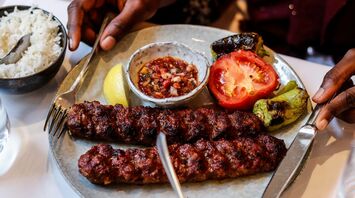Turkish Cuisine: A Vegetarian Delight According to Özlem Warren

Featuring an array of fruits, vegetables, and nuts, Turkish cuisine offers much more than just kebabs. In her new book, Özlem Warren celebrates the vegetarian dishes of her homeland.
Early Food Memories
Özlem Warren's earliest food memories are from her childhood in Antakya, southeast Turkey, where she spent holidays at her grandparents' 450-year-old stone house. She recalls her grandmother making molasses from homegrown walnuts, figs, and pomegranates. Her family, deeply involved in food trade, brought fresh produce home, ensuring nothing was wasted. Trips to the bakery and farmers' market with her father were cherished moments, selecting fresh ingredients and interacting with vendors.
Markets and Community
Markets remain central to Turkish life, reflecting regional diversity and offering a vast variety of local produce. Each neighborhood has its market, featuring regional ingredients straight from the producers, including olives, pickles, and cheese. Bakeries, pivotal to Turkish culinary tradition, offer fresh pide and somun loaves daily, serving as community hubs where locals gather and often use communal ovens.
Key Ingredients in Turkish Cooking
The Ottoman Empire significantly influenced Turkish cuisine, bringing diverse spices and produce to the royal kitchens. Essential ingredients include cumin, sumac, and pul biber (Aleppo pepper), used both in cooking and as a table seasoning. Yoghurt, omnipresent in Turkish dishes, appears in dips, meze, and desserts. Turkey also produces high-quality nuts like almonds from Datça, pistachios from Gaziantep, and hazelnuts from the Black Sea.
Regional Culinary Diversity
Turkey's vast landscape and diverse ethnic communities result in distinct regional cuisines. The Black Sea region emphasizes tea, corn, anchovies, and butter, reflecting Ottoman influence. Southern Turkey features spicy dishes, pomegranate molasses, and bulgur, with a tradition of drying produce for preservation. Mainland Anatolia, the home of wheat, offers hearty foods for long winters, while southeast Anatolia is famous for baklava. The Aegean region, influenced by Mediterranean flavors, focuses on citrus, herbs, fish, and vegetables cooked in olive oil.
Istanbul's Food Scene
Istanbul, known for its welcoming and diverse atmosphere, boasts a food scene enriched by immigrant communities. Markets like Misir Carsisi spice market in the Old City showcase regional specialties, including spices, dried fruit, and nuts. The city's street food is vibrant, with offerings like baked potatoes with various toppings in Ortaköy Square, gözleme (filled flatbread), and simit (sesame-encrusted bread rings) enjoyed on ferry trips across the Bosphorus.
Surprising Aspects of Turkish Cuisine
While kebabs are popular, Turkish home cooking focuses on vegetarian dishes. Warren's cookbook highlights the variety of vegetarian foods in Turkey, including pulses, legumes, whole grains, casseroles, filled breads, pastries, vegetable meze, and pickles. Turkish cuisine is seasonal, wholesome, and frugal, emphasizing sharing and community, reflecting the spirit of hospitality that defines the culture.



















